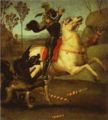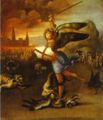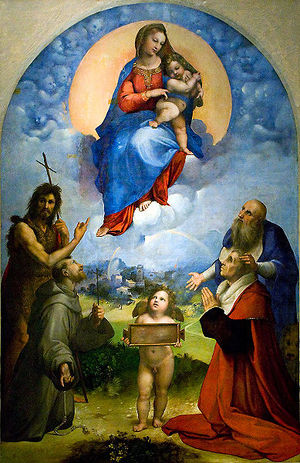Difference between revisions of "Raphael"
DavidB4-bot (Talk | contribs) (ââtop: clean up & uniformity) |
|||
| (24 intermediate revisions by 8 users not shown) | |||
| Line 1: | Line 1: | ||
| â | [[Image:Raphael..jpg|left]] | + | [[Image:Raphael..jpg|thumb|left]] |
| â | Raffaello Santi (or Sanzio) known as '''Raphael''' | + | '''Raffaello Santi (or Sanzio)''' (1483-1520), known as '''Raphael''', was born in Urbino, [[Italy]]. He mastered the use of color and painted beautiful frescoes in churches and for private patrons, the most famous of which may be ''The School of Athens'' (1509), an interesting painting depicting Plato and Aristotle surrounded by their pupils. |
| â | + | ''Raffaelo Sanzio was the youngest of the three giants of the High Renaissance... One of the most frequently discussed and best-loved paintings of the Renaissance is Raphael's so-called Sistine Madonna. For many people it remains the supreme example of western painting, and its popularity is virtually as great as that of the [[Mona Lisa]].'' <ref> | |
[http://www.artchive.com/artchive/R/raphael.html Raffaelo Sanzio] ARTCHIVE. | [http://www.artchive.com/artchive/R/raphael.html Raffaelo Sanzio] ARTCHIVE. | ||
| â | + | </ref> | |
He was inspired by two of the greatest artists in the history of the world: [[Michelangelo]] and [[Leonardo da Vinci]]. Both of whom were in Florence during the time that Raphael was working in the studio of Perugino. Soon ''he began to adopt Michelangelo's vigorous energy and Leonardo's sfumato and spiritualism.'' | He was inspired by two of the greatest artists in the history of the world: [[Michelangelo]] and [[Leonardo da Vinci]]. Both of whom were in Florence during the time that Raphael was working in the studio of Perugino. Soon ''he began to adopt Michelangelo's vigorous energy and Leonardo's sfumato and spiritualism.'' | ||
| â | Raphael lived an active life. The numerous architectural and painting commissions he received caused him to overwork. He died at the age of thirty-seven. <ref> | + | Raphael lived an active life. The numerous architectural and painting commissions he received caused him to overwork. He died at the age of thirty-seven.<ref> |
[http://www.3d-dali.com/Artist-Biographies/Raphael_Sanzio.html Raffaelo Sanzio] Painters BIOGRAPHIES. | [http://www.3d-dali.com/Artist-Biographies/Raphael_Sanzio.html Raffaelo Sanzio] Painters BIOGRAPHIES. | ||
| â | + | </ref> | |
| â | + | {{clear}} | |
| â | + | <center> | |
| â | + | <gallery perrow="5"> | |
| â | <gallery> | + | |
Image:Raphael Disputa.jpg|Dispute Over the Sacrament | Image:Raphael Disputa.jpg|Dispute Over the Sacrament | ||
Image:School of Athens.jpg|The School of Athens | Image:School of Athens.jpg|The School of Athens | ||
Image:Raphael St. George.jpg|St. George | Image:Raphael St. George.jpg|St. George | ||
| + | Image:Raphael Allegory.jpg|Allegory (The Knight's Dream) | ||
| + | Image:Raphael Canigiani Holy Family.jpg|Canigiani Holy Family | ||
| + | Image:Raphael Crucifixion.jpg|Crucifixion | ||
| + | Image:Raphael St. Michael.jpg|St. Michael | ||
| + | Image:Raffael Die kleine Cowper-Madonna.jpg|The Small Cowper Madonna | ||
| + | Image:Rafael Madonna of the chair.jpeg|Madonna della Seggiola | ||
| + | File:Raphael The Transfiguration of Christ is the final work of Raphael ca 1520.jpg|The Transfiguration of Christ | ||
</gallery> | </gallery> | ||
| + | |||
| + | |||
| + | [[Image:Raphael The Sistine Madonna.jpg|thumb|center|The Sistine Madonna]] | ||
| + | </center> | ||
| + | |||
| + | <blockquote> | ||
| + | Five hundred years ago Raphael, the great master painter of the Renaissance, was commissioned by Pope Julius II to paint the Sistine Madonna. Today, it is one of the most famous works of art in the world. It belongs to the Gemäldegalerie Alte Meister in Dresden. [http://www.dresden-events.com/index.php/details/events/the-sistine-madonna.html] | ||
| + | </blockquote> | ||
== See also == | == See also == | ||
| + | [[File:Madonna di Foligno - Raffaello Sanzio.jpg|thumb|Madonna di Foligno, 1511-1512.]] | ||
*[[Painting Masterpieces]] | *[[Painting Masterpieces]] | ||
*[[Painting Schools]] | *[[Painting Schools]] | ||
| + | *[[Gallery of Italian Masterpieces]] | ||
| + | |||
| + | == External links == | ||
| + | |||
| + | *[http://www.eyeconart.net/history/Renaissance/raphael.htm Raphael Sanzio] | ||
| + | *[http://www.artist-biography.info/artist/raphael/ RAPHAEL OF URBINO] | ||
==References== | ==References== | ||
<references/> | <references/> | ||
| â | [[Category: | + | [[Category:Italian Painters]] |
| â | + | ||
Latest revision as of 00:37, July 12, 2016
Raffaello Santi (or Sanzio) (1483-1520), known as Raphael, was born in Urbino, Italy. He mastered the use of color and painted beautiful frescoes in churches and for private patrons, the most famous of which may be The School of Athens (1509), an interesting painting depicting Plato and Aristotle surrounded by their pupils.
Raffaelo Sanzio was the youngest of the three giants of the High Renaissance... One of the most frequently discussed and best-loved paintings of the Renaissance is Raphael's so-called Sistine Madonna. For many people it remains the supreme example of western painting, and its popularity is virtually as great as that of the Mona Lisa. [1]
He was inspired by two of the greatest artists in the history of the world: Michelangelo and Leonardo da Vinci. Both of whom were in Florence during the time that Raphael was working in the studio of Perugino. Soon he began to adopt Michelangelo's vigorous energy and Leonardo's sfumato and spiritualism. Raphael lived an active life. The numerous architectural and painting commissions he received caused him to overwork. He died at the age of thirty-seven.[2]
Five hundred years ago Raphael, the great master painter of the Renaissance, was commissioned by Pope Julius II to paint the Sistine Madonna. Today, it is one of the most famous works of art in the world. It belongs to the Gemäldegalerie Alte Meister in Dresden. [1]
See also
External links
References
- â Raffaelo Sanzio ARTCHIVE.
- â Raffaelo Sanzio Painters BIOGRAPHIES.












